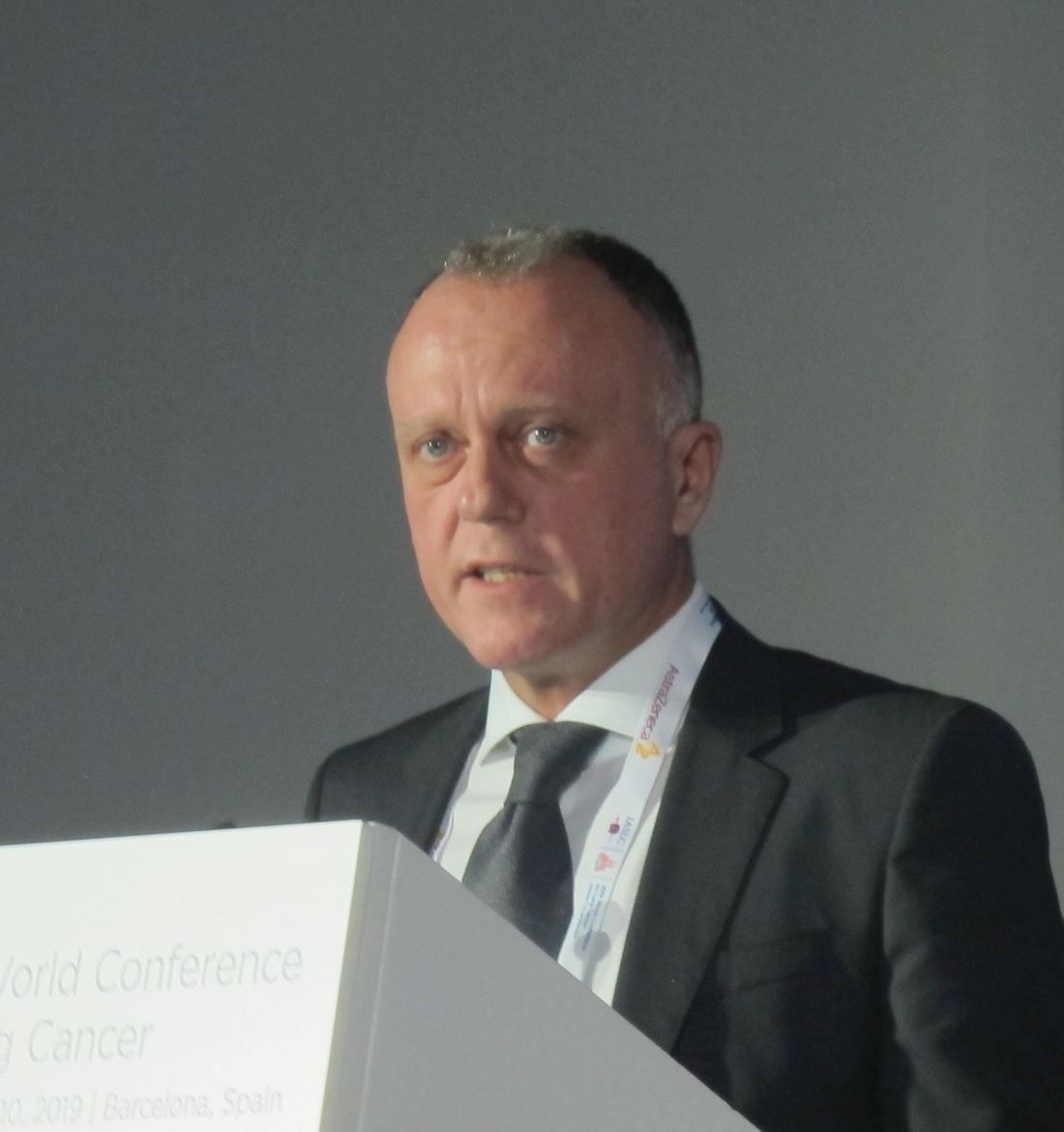User login
BARCELONA – Final overall survival (OS) did not differ significantly among patients with stage IV squamous non–small cell lung carcinoma who were treated with either first-line atezolizumab + chemotherapy or chemotherapy alone in the phase 3 IMpower131 trial.
Median OS in the intent-to-treat population was 14.2 months vs. 13.5 months with vs. without the programmed death-ligand 1 (PD-L1) inhibitor atezolizumab, respectively (hazard ratio, 0.88), Federico Cappuzzo, MD, director of medical oncology at Azienda Unità Sanitaria Locale della Romagna-Ravenna, Italy, reported at the World Conference on Lung Cancer.
However, patients with high PD-L1 expression (14% and 13% of patients in the groups, respectively), experienced a clinically meaningful improvement in OS with atezolizumab + chemotherapy vs. chemotherapy alone (median of 23.4 vs. 10.2 months; HR, 0.48), Dr. Cappuzzo said at the conference, which was sponsored by the International Association for the Study of Lung Cancer.
“This means we had a reduction in the risk of death that was more than 50%,” he said, adding that no new or unexpected safety signals were reported.
IMpower131 randomized 1,021 patients with a median age of 65 years 1:1:1 to receive either atezolizumab (1,200 mg) + carboplatin (area under the curve 6) + paclitaxel (200 mg/m2) every 3 weeks, or atezolizumab + carboplatin + nab-paclitaxel (100 mg/m2 every week), or carboplatin + nab-paclitaxel for four or six cycles. Patients in the first two arms (A and B) received atezolizumab maintenance therapy until loss of clinical benefit or progressive disease occurred, and those in latter arm (C) received best supportive care after completing the treatment cycles.
The current analysis compared only the OS outcomes for arms B and C. Results of the primary analysis of investigator-assessed progression-free survival (PFS) – a coprimary endpoint of the trial – were reported in 2018 at the annual meeting of the American Society of Clinical Oncology and showed a statistically significant improvement in median PFS in arm B vs. arm C (6.3 vs. 5.6 months; HR, 0.715). The PFS benefit was seen in all PD-L1-positive subgroups.
“This was a very incredible trial, because it was conducted in a group of patients in which we need additional therapies – patients with squamous histology,” Dr. Cappuzzo said during a press briefing at the conference. “IMpower131 is certainly a positive study; we had PFS, as an independent coprimary endpoint, improve significantly, with a meaningful survival difference in the group of patients with strongly positive PD-L1 tumors.
“So these data clearly suggest that [patients with high PD-L1 expression), specifically, may benefit from the combination of chemotherapy and atezolizumab.”
He further noted in a press statement that “the findings provide additional evidence of the efficacy of immunotherapy in patients with lung cancer, and highlight the relevance of biomarkers for patient selection.”
Dr. Cappuzzo reported having no disclosures.
SOURCE: Cappuzzo F et al. WCLC 2019, Abstract OS14.02 .
BARCELONA – Final overall survival (OS) did not differ significantly among patients with stage IV squamous non–small cell lung carcinoma who were treated with either first-line atezolizumab + chemotherapy or chemotherapy alone in the phase 3 IMpower131 trial.
Median OS in the intent-to-treat population was 14.2 months vs. 13.5 months with vs. without the programmed death-ligand 1 (PD-L1) inhibitor atezolizumab, respectively (hazard ratio, 0.88), Federico Cappuzzo, MD, director of medical oncology at Azienda Unità Sanitaria Locale della Romagna-Ravenna, Italy, reported at the World Conference on Lung Cancer.
However, patients with high PD-L1 expression (14% and 13% of patients in the groups, respectively), experienced a clinically meaningful improvement in OS with atezolizumab + chemotherapy vs. chemotherapy alone (median of 23.4 vs. 10.2 months; HR, 0.48), Dr. Cappuzzo said at the conference, which was sponsored by the International Association for the Study of Lung Cancer.
“This means we had a reduction in the risk of death that was more than 50%,” he said, adding that no new or unexpected safety signals were reported.
IMpower131 randomized 1,021 patients with a median age of 65 years 1:1:1 to receive either atezolizumab (1,200 mg) + carboplatin (area under the curve 6) + paclitaxel (200 mg/m2) every 3 weeks, or atezolizumab + carboplatin + nab-paclitaxel (100 mg/m2 every week), or carboplatin + nab-paclitaxel for four or six cycles. Patients in the first two arms (A and B) received atezolizumab maintenance therapy until loss of clinical benefit or progressive disease occurred, and those in latter arm (C) received best supportive care after completing the treatment cycles.
The current analysis compared only the OS outcomes for arms B and C. Results of the primary analysis of investigator-assessed progression-free survival (PFS) – a coprimary endpoint of the trial – were reported in 2018 at the annual meeting of the American Society of Clinical Oncology and showed a statistically significant improvement in median PFS in arm B vs. arm C (6.3 vs. 5.6 months; HR, 0.715). The PFS benefit was seen in all PD-L1-positive subgroups.
“This was a very incredible trial, because it was conducted in a group of patients in which we need additional therapies – patients with squamous histology,” Dr. Cappuzzo said during a press briefing at the conference. “IMpower131 is certainly a positive study; we had PFS, as an independent coprimary endpoint, improve significantly, with a meaningful survival difference in the group of patients with strongly positive PD-L1 tumors.
“So these data clearly suggest that [patients with high PD-L1 expression), specifically, may benefit from the combination of chemotherapy and atezolizumab.”
He further noted in a press statement that “the findings provide additional evidence of the efficacy of immunotherapy in patients with lung cancer, and highlight the relevance of biomarkers for patient selection.”
Dr. Cappuzzo reported having no disclosures.
SOURCE: Cappuzzo F et al. WCLC 2019, Abstract OS14.02 .
BARCELONA – Final overall survival (OS) did not differ significantly among patients with stage IV squamous non–small cell lung carcinoma who were treated with either first-line atezolizumab + chemotherapy or chemotherapy alone in the phase 3 IMpower131 trial.
Median OS in the intent-to-treat population was 14.2 months vs. 13.5 months with vs. without the programmed death-ligand 1 (PD-L1) inhibitor atezolizumab, respectively (hazard ratio, 0.88), Federico Cappuzzo, MD, director of medical oncology at Azienda Unità Sanitaria Locale della Romagna-Ravenna, Italy, reported at the World Conference on Lung Cancer.
However, patients with high PD-L1 expression (14% and 13% of patients in the groups, respectively), experienced a clinically meaningful improvement in OS with atezolizumab + chemotherapy vs. chemotherapy alone (median of 23.4 vs. 10.2 months; HR, 0.48), Dr. Cappuzzo said at the conference, which was sponsored by the International Association for the Study of Lung Cancer.
“This means we had a reduction in the risk of death that was more than 50%,” he said, adding that no new or unexpected safety signals were reported.
IMpower131 randomized 1,021 patients with a median age of 65 years 1:1:1 to receive either atezolizumab (1,200 mg) + carboplatin (area under the curve 6) + paclitaxel (200 mg/m2) every 3 weeks, or atezolizumab + carboplatin + nab-paclitaxel (100 mg/m2 every week), or carboplatin + nab-paclitaxel for four or six cycles. Patients in the first two arms (A and B) received atezolizumab maintenance therapy until loss of clinical benefit or progressive disease occurred, and those in latter arm (C) received best supportive care after completing the treatment cycles.
The current analysis compared only the OS outcomes for arms B and C. Results of the primary analysis of investigator-assessed progression-free survival (PFS) – a coprimary endpoint of the trial – were reported in 2018 at the annual meeting of the American Society of Clinical Oncology and showed a statistically significant improvement in median PFS in arm B vs. arm C (6.3 vs. 5.6 months; HR, 0.715). The PFS benefit was seen in all PD-L1-positive subgroups.
“This was a very incredible trial, because it was conducted in a group of patients in which we need additional therapies – patients with squamous histology,” Dr. Cappuzzo said during a press briefing at the conference. “IMpower131 is certainly a positive study; we had PFS, as an independent coprimary endpoint, improve significantly, with a meaningful survival difference in the group of patients with strongly positive PD-L1 tumors.
“So these data clearly suggest that [patients with high PD-L1 expression), specifically, may benefit from the combination of chemotherapy and atezolizumab.”
He further noted in a press statement that “the findings provide additional evidence of the efficacy of immunotherapy in patients with lung cancer, and highlight the relevance of biomarkers for patient selection.”
Dr. Cappuzzo reported having no disclosures.
SOURCE: Cappuzzo F et al. WCLC 2019, Abstract OS14.02 .
REPORTING FROM WCLC 2019

